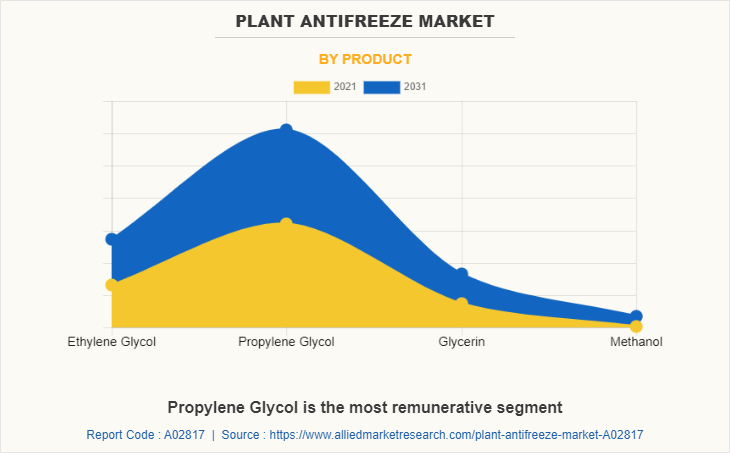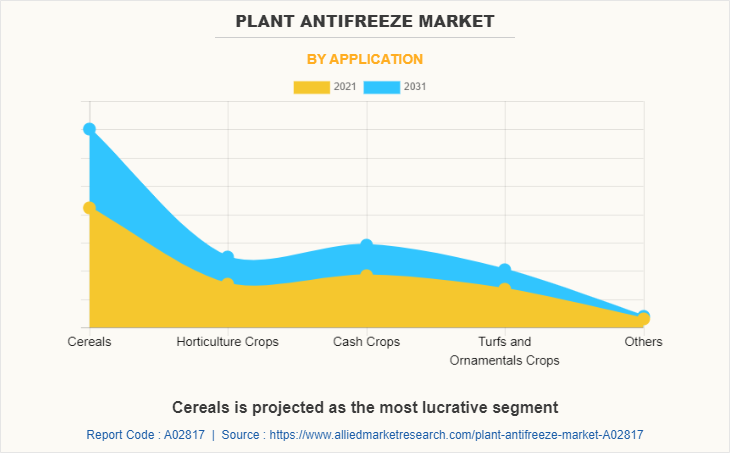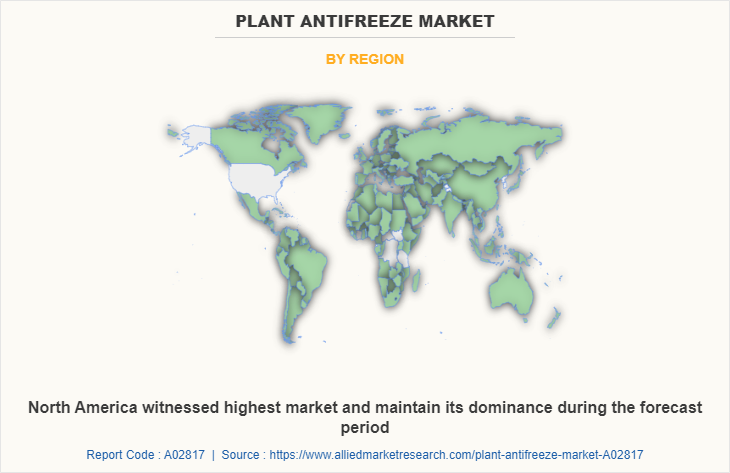Plant Antifreeze Market Research, 2031
The global plant antifreeze market size was valued at $1.9 billion in 2021, and is projected to reach $3.0 billion by 2031, growing at a CAGR of 5.0% from 2022 to 2031.
The supply of agro-food products to marketers and consumers are held both within and across the border during the first quarter of 2020. Also, several synthetic plant antifreeze product manufacturing companies have either shut down or shrank their operations due to the risk of infection among the workforce. This has temporarily hampered the demand and supply chain of plant antifreeze market
Plant antifreeze are chemicals, which reduce the freezing point of water inside the tissues of plants. These chemicals help plants to endure temperatures 2.2 to 9.4F colder than usual, depending upon the species. Antifreeze chemicals such as ethylene glycol, propylene glycol, glycerin, and others stimulate plants to produce antifreeze proteins and antifreeze amino acids to prevent itself against cold and frost temporarily.

The factors such as rise in industrialization, increase in disposable income, and growth and expansion of the agriculture sector & horticulture sector in developing economies have surged the demand for antifreeze products such as ethylene glycol, glycerin, propylene glycol, and others. These chemicals avoid damage to plants in extreme cold weather and also help in reducing the freezing point of water inside the tissues of plants. In addition to this, antifreeze chemicals such as ethylene glycol, propylene glycol, glycerin, and others stimulate plants to produce antifreeze proteins and antifreeze amino acids to prevent itself against cold and frost temporarily. This is anticipated to drive the plant antifreeze market growth.
However, fluctuations in the prices and unavailability of raw materials will pose a major challenge to the growth of the plant antifreeze market. Furthermore, the requirement of huge expenditure for research and development activities and for setting up new manufacturing plants for plant antifreeze chemicals such as ethylene glycol, mono ethylene, glycerin, and others will further slows down the plant antifreeze market growth rate.
On the contrary, growth and expansion of agricultural industry and horticulture industry, especially in the developing economies coupled with increasing personal disposable income will further create lucrative and remunerative growth opportunities for the plant antifreeze market. Rise in industrialization, surge in globalization and increase in focus of the farmers toward multiplications of productivity carve the way for the growth of the plant antifreeze market. Plant antifreeze chemicals help in lowering the budget for heating technologies and in turn boost the market growth. These factors are predicted to contribute to the global market growth and are anticipated to offer new opportunities in the global plant antifreeze market.
The global plant antifreeze market analysis is provided on the basis of by product ethylene glycol, propylene glycol, glycerin, methanol, and others, and by application (cereals, horticulture crops, cash crops, turfs and ornamental crops, and others. Region-wise, the market is analyzed across North America, Europe, Asia-Pacific, and LAMEA. The major companies profiled in this report include BASF SE, ADAMA, Bayer AG, Chevron Phillips Chemical Company LLC, DuPont, ExxonMobil Corporation, Gharda Chemicals Ltd, Nufarm, Sumitomo Chemical Co., Ltd., and Syngenta.

In 2021, the propylene glycol segment was the largest revenue generator, and is anticipated to grow at a CAGR of 5.5% during the forecast period. Propylene glycol helps in preventing the crops from frost in subzero temperature that enhances the plant productivity and stimulates the plants to secrets plants antifreeze chemicals in extreme cold weathers owing to such superior functionality it is escalating demand for propylene glycol

By application, the cereals segment dominated the global market in 2021, and is anticipated to grow at a CAGR of 5.3% during forecast period. This is attributed to the fact that plant antifreeze accounts for around 46% of global plant antifreeze market share. The cereals and grains market is witnessing high growth owing to having a rich source of vitamins and minerals, and are used in large amounts in animal feed owing to these factors manufacturer have put more emphasis on the production of plant antifreeze chemicals that will help in cereal production during subzero temperature.

The North America plant antifreeze market size is projected to grow at the highest CAGR of 4.4% during the forecast period, in 2021, with 35% major share in the global market. The turf and ornamental sector has accounted one of the highest revenue generating sector in the North America, owing to rising awareness about plant antifreeze chemicals especially in the developing economies is emerge as the major factor fostering the growth of plant antifreeze market in the North America region.
IMPACT OF COVID-19 ON THE GLOBAL PLANT ANTIFREEZE MARKET
The novel coronavirus is an incomparable global pandemic that has spread to over 180 countries and caused huge losses of lives and the economy around the globe. The plant antifreezes market has little impact due to the wake of the COVID-19 pandemic, owing to the disruptions in the supply chain for various agrochemical products. According to a report published by the Organization for Economic Co-operation and Development (OECD), the decreased consumer demand has put downward pressure on the prices and production of plant antifreeze products. Due to the spread of the coronavirus pandemic, the manufacturer has faced challenges in terms of operation and supply chain due to government restrictions during the lockdown. The guidelines and policies of logistics and supply chain of the agro-food and chemical market were affected remarkably. Moreover, the supply of agro-food products to marketers and consumers are held both within and across the border during the first quarter of 2020. Also, several synthetic plant antifreeze industry product manufacturing companies have either shut down or shrank their operations due to the risk of infection among the workforce. This has temporarily hampered the demand and supply chain of plant antifreeze market. In addition, the falling income of customers has led contraction in the demand for ethylene glycol, glycerin, and other crop protection antifreeze products among the small farmers during the COVID-19 period. Furthermore, several chemical manufacturing companies have adopted safety strategies and techniques which in turn may increase the demand for plant antifreezes as the market starts stabilizing. According to an article published by AgriBusiness Global, the demand for crop protection products in Russia rose by 20% in 2021 and is expected to further grow during the second quarter of the year.
Key Benefits For Stakeholders
- This report provides a quantitative analysis of the market segments, current trends, estimations, and dynamics of the plant antifreeze market analysis from 2021 to 2031 to identify the prevailing plant antifreeze market opportunities.
- The market research is offered along with information related to key drivers, restraints, and opportunities.
- Porter's five forces analysis highlights the potency of buyers and suppliers to enable stakeholders make profit-oriented business decisions and strengthen their supplier-buyer network.
- In-depth analysis of the plant antifreeze market segmentation assists to determine the prevailing market opportunities.
- Major countries in each region are mapped according to their revenue contribution to the global market.
- Market player positioning facilitates benchmarking and provides a clear understanding of the present position of the market players.
- The report includes the analysis of the regional as well as global plant antifreeze market trends, key players, market segments, application areas, and market growth strategies.
Plant Antifreeze Market Report Highlights
| Aspects | Details |
| By Product |
|
| By Application |
|
| By Region |
|
Analyst Review
According to CXOs of leading companies, the plant antifreeze market is expected to witness considerable growth. This is attributed to a significant surge in the demand from agriculture, horticulture, turf and ornamentals, and other end-users. Plant antifreeze chemicals such as ethylene glycol, propylene, glycerin, and others are used extensively in the agriculture, gardening, organic farming, horticulture and others. These chemicals protect the crops from frost and prevent damaging during subzero temperature.
In addition, these chemicals help in stimulating plant antifreeze amino acid to prevent itself against cold and frost temporarily. Rise in concern from governments across emerging nations, such as China, India, and South Korea, regarding agriculture sector during extreme cold temperature is expected to drive the market growth. Governments across different countries implement new chemicals and agriculture schemes on excess amount. This is expected to enhance the market penetration in new customer segments.
CXOs further added that sustained economic growth and the development of the agriculture sector have surged the popularity of plant antifreeze chemicals.
Growing agriculture industry escalating the demand for plant antifreeze products which will drive the market growth.
BASF SE, ADAMA, Bayer AG, Chevron Phillips Chemical Company LLC, DuPont, ExxonMobil Corporation, Gharda Chemicals Ltd, Nufarm, Sumitomo Chemical Co., Ltd., and Syngenta are the most established players in the global plant antifreeze market.
The global plant antifreeze market was valued at $1.9 billion in 2021, and is projected to reach $3.0 billion by 2031, growing at a CAGR of 5.0% from 2022 to 2031.
The factors such as rise in industrialization, increase in disposable income, and growth and expansion of the agriculture sector & horticulture sector in developing economies have surged the demand for antifreeze products such as ethylene glycol, glycerine, propylene glycol, and others. These products avoid damage to plants in extreme cold weather and also helps in reducing the freezing point of water inside the tissues of plants.
The plant antifreeze market is segmented on the basis of product, application, and region. On the basis of product, the market is categorized into product, the market is segregated into ethylene glycol, propylene glycol, glycerine, and methanol. On the basis of application, into cereals, horticulture crops, cash crops, turfs and ornamental crops, and others. Region-wise, the market is studied across North America, Europe, Asia-Pacific, and LAMEA.
Cash crops sector is projected to increase the demand of plant antifreeze market
The cereals segment dominated the global market in terms of revenue in 2021, with 46% of the total share. The cereals and grains market is witnessing high growth as they are a rich source of vitamins and minerals, and are used in large amounts in animal feed. Owing to these factors manufacturers have put more emphasis on the production of plant antifreeze chemicals. It will help in cereal production during subzero temperature.
The novel coronavirus is an incomparable global pandemic that has spread to over 180 countries and caused huge losses of lives and the economy around the globe. The plant antifreezes market has little impact due to the wake of the COVID-19 pandemic, owing to the disruptions in the supply chain for various agrochemical products.
Loading Table Of Content...



